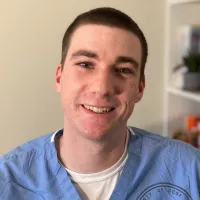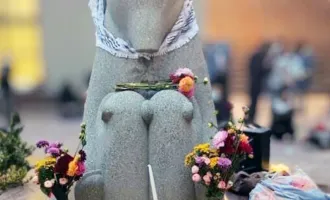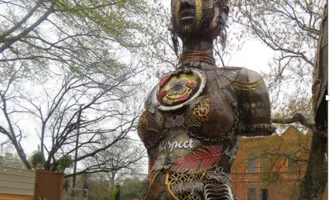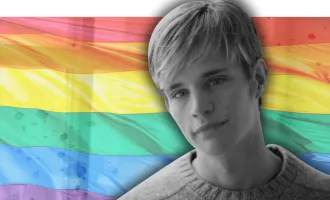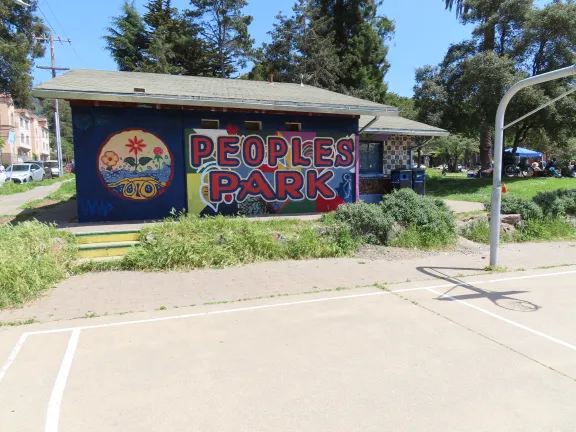
Police Violence and the Creation of the Berkeley Free Clinic
This entry earned author Henry Carter first place in the personal essay category of the 2020 Synapse Storytelling Contest, which he shares with story editor Le Wen Chiu.
On June 3, 2020, thousands of health workers from around the country attended an online street medic training presented by Dr. Rupa Marya of the Do No Harm Coalition. The seminar included an overview of police weapons, the injuries they cause, and how best to treat these injuries. Later that day, I joined dozens of my UCSF colleagues at a Black Lives Matter demonstration in the Mission District. We distributed supplies to demonstrators, and some of us carried first aid kits and spray bottles to rinse tear gas out of eyes. Many health workers seemed eager to fight against the racist and militarized police forces that terrorize our neighbors.
The Berkeley Free Clinic (BFC) emerged in a similarly chaotic moment in 1969 as a non-professional effort to heal protestors injured by police. The existence of the BFC still to this day is a testament that a community’s impromptu response to police violence can create enduring institutions that fight for justice for decades.
In the late 1960’s, the Telegraph Ave neighborhood of South Berkeley was a national center of student activism, political radicalism, and counterculture. Young people from all over the country flocked to Berkeley to experience the scene, but many struggled to find adequate housing and other services. In 1967, the Sather’s Gate Merchant’s Association and the Presbyterian Board of National Missions funded a group that became known as the Berkeley Free Church to conduct outreach and provide basic social services to this new class of countercultural “street people” in Berkeley’s southside.
The Church’s Reverend, Dick York, collaborated with local merchants and UC Berkeley students to organize a free clinic inspired by the Haight Ashbury Free Clinic across the Bay. In the middle of their preparations, the Battle for People’s Park erupted. The Berkeley Free Church fast-tracked the creation of the clinic in response to the unprecedented police violence.
The University of California (UC) fired the first shot in the Battle for People’s Park in 1967 when it used eminent domain law to acquire the block of land off of Telegraph Avenue between Haste Street and Dwight Way and demolished the 24 buildings that stood there. The demolition of the block was described by UC regent Fred Dutton as “an intentional act against the hippie culture.”
The demolition site was left vacant and rapidly became an eyesore, often referred to as “the swamp” because of the muddy pools that collected in it. In 1969, after watching the site decay for close to a year, a small group of Telegraph merchants and activists decided to beautify the lot, without the permission of the UC. The group announced their plan in Berkeley’s underground periodicals, and on April 20, the first day of the beautification project, over 200 people arrived to lend a hand. Over the next month, the hundreds of impromptu landscapers laid sod and winding stone paths, planted flowers and trees, constructed an amphitheater, installed a playground, and altogether transformed the swamp into a thriving community park. By May 11, when Reverend York consecrated the park, it was clear that the counterculture had rebuked the UC’s opening volley and had reclaimed the park for itself.
From April 20 to May 15, People’s Park was a site of joyous recreation and a symbol of victory for hippies, but for local authorities, it was seen as an illegal occupation of private property. As such, the Berkeley Police Department (BPD) and UC decided to retake the land by force.
Over the previous year, Berkeley’s campus had been roiled by escalating unrest, and the BPD and UC had become bolder in their use of violence against students. Tear gas was first deployed by the BPD in May 1968 during a student demonstration. As the social and political unrest grew that summer, tear gas, beatings and mass arrests became routine on the streets of Berkeley. In early 1969, when students of color at UC Berkeley threatened a campus-wide strike, Governor Ronald Reagan declared “a state of extreme emergency,” which authorized state officials to bring in the National Guard and other troops into the city. The state of emergency was still in effect while People’s Park was being built in April and May of that year.
In order to prepare for the violence that would unfold when the UC finally moved to retake the park, Reverend York reached out to Chuck McCallister, a Korean War veteran who developed street medic protocols for protests. In the lead up to and during the Battle, McCallister helped train hundreds of non-professional street medics and organized 5 guerilla first aid stations and 10 private “ambulances” for injured protestors. Non-professional street medics were needed because the police department was associated with most official emergency medical services and often prevented these services from accessing injured protestors.
The BPD made its move early in the morning of May 15, 1969. Supplemented by hundreds of California Highway Patrol officers, they retook the lot, easily dispersing the 75 youthful demonstrators tasked with guarding the park overnight. A bulldozer immediately began destroying large sections of the Park’s landscaping in order to erect a chain-link fence around its perimeter.
Word quickly spread and by noon, thousands of students gathered for a rally at Sproul Plaza. As the angry crowds grew, state officials called in police officers from other cities. By the time the mass of students began marching down Telegraph Ave to retake the park, there were 800 police officers from numerous jurisdictions blocking their path at Haste St. A fire hydrant was opened by protestors, and some reported seeing bottles and rocks being thrown at the police. Police began beating demonstrators with their clubs and fired tear gas cannisters into the crowd. Some of the canisters were thrown back into the police ranks. As tensions escalated, a car was overturned and lit on fire at the corner of Dwight and Telegraph.
At a certain point, the heterogenous and poorly coordinated police army lost any semblance of discipline and descended into random violence against unarmed protestors. It was a police riot. Officers, many of whom had recently returned from Vietnam, began firing buckshot from shotguns indiscriminately into the crowd and into groups of bystanders watching from rooftops. When demonstrators panicked and dispersed, small roving groups of San Francisco Police Department Tactical Squad Officers and Alameda County Sheriff’s Deputies pursued, firing buckshot into any crowds that formed.
That day, over 50 demonstrators were hospitalized, most of whom were students, and at least 30 of them had buckshot wounds. A handful were permanently maimed. Alan Blanchard lost his sight after being shot in the eyes. Donovan Rundle suffered for the rest of his life from complications of a buckshot wound to the gut. James Rector, who had been observing from a rooftop, died from buckshot wounds he received.
Under orders from Governor Reagan, the CA National Guard occupied the city of Berkeley the following day, establishing a 10PM curfew as well as a ban on assemblies of any size. For the next two weeks, Berkeley’s state of martial law was punctuated by violent street skirmishes and bold acts designed to scare citizens into submission. On May 20, a National Guard military helicopter unleashed tear gas over the Berkeley campus to disperse a demonstration, but officers prevented the protestors from leaving, forcing the students to endure what was described as a “gas chamber experiment.” The toxic gas permeated Cowell Hospital as well as a number of elementary and middle schools. On May 22, National Guardsmen rounded up close to 500 random people on Shattuck Ave, arrested them all, and sent them to Santa Rita Corrections Facility, where they were subjected to hours of cruel and humiliating abuses by jailers.
During these weeks of violence and unrest, the Berkeley Free Church Medics trained by McAllister were ubiquitous. An article in the Berkeley Barb explained, “the street medics that handed out wet towels for gas-blinded eyes, set splints and hugged bodies convulsing from concussion, became the core of the Berkeley Free Clinic.”
By May 25, the well-connected members of the Berkeley Free Church helped secure an unused space in the abandoned McKinley School from the city to be the temporary site of a field hospital for the non-professional street medics. McCallister and his medics were so reviled by local authorities for supporting student protesters that the BPD raided the clinic, throwing an X-ray machine and medic down the stairs in the process. That medic reported two broken wrists and a broken jaw from the police raid.
Despite its openly antagonistic relationship with the BPD, the Berkeley Free Clinic became one of Berkeley’s most enduring counterculture landmarks and continues to serve the people of Berkeley to this day. The compassion, bravery, and creativity from that original period of strife ultimately created a long-lasting institution. This history demonstrates that the passion and energy many health workers feel in today’s struggles against police violence can be channeled into enduring change.
